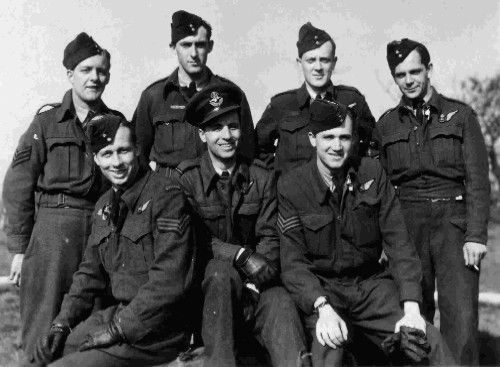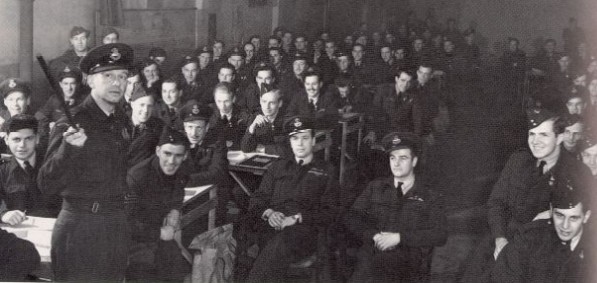The following story was initially published in "Airforce" The Magazine of Canada's Air Force Heritage - Vol 27 No 1. Spring 2003. Published for second time in "No Prouder Place" Canadians and the Bomber Command Experience 1939 - 1945" David Bashow.
Since this story was published I have uncovered further history of this night and added a correction on the Luftwaffe Nightfighter Pilot at bottom of page.
NIGHT RAID ON HAPPY VALLEY
By Alan Soderstrom
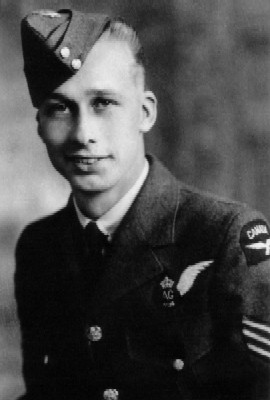 In the early evening of Saturday, June 16th, 1944, Bomber crews from 431, and 434 Squadrons sit in a briefing hall located at Croft, Yorkshire. The following crew will be going on their 20th operational Sortie; W/O1Mike Laffin, Pilot; F/O Jim Martin, Navigator; F/O Greg Chapman, Bomb-Aimer; F/S Ken Donaldson, Wireless Operator-Air Gunner; Sgt. Clarence Soderstrom, Mid-Upper-Air Gunner; Sgt. Cliff Wentworth, Rear-Air Gunner; Sgt. Edward Druett, Flight Engineer.
In the early evening of Saturday, June 16th, 1944, Bomber crews from 431, and 434 Squadrons sit in a briefing hall located at Croft, Yorkshire. The following crew will be going on their 20th operational Sortie; W/O1Mike Laffin, Pilot; F/O Jim Martin, Navigator; F/O Greg Chapman, Bomb-Aimer; F/S Ken Donaldson, Wireless Operator-Air Gunner; Sgt. Clarence Soderstrom, Mid-Upper-Air Gunner; Sgt. Cliff Wentworth, Rear-Air Gunner; Sgt. Edward Druett, Flight Engineer.
Left: Sgt. Clarence Soderstrom
At numerous other airfields across southern England hundreds of other airmen are receiving briefings on their intended enemy targets.
Outside it is overcast, raining, and the wind is gusting. Parked on the tarmac, Halifax bomber Mk. III, serial No. LK-801, coded WL-D is being loaded with 18 bombs, each weighing 500 pounds. The mid-upper gun turret is being loaded with 10,000 rounds of .303 cal. ammunition, to be fired from four Browning machine guns; down below in the tail of the Aircraft, the rear turret will receive the same service. The fuel tanks are being topped up, to feed four Bristol Hercules engines at a cruising speed of approximately 165 miles per hour. All-up weight of the Halifax is 65,000 pounds (29,500 kg).
Back at the briefing hall, the crews are being assigned their target, the Sterkrade-Holten synthetic-oil plant situated on the north-western outskirts of Essen, Germany. Chemical plants and factories also make up this industrial zone, all positioned along the Ruhr River. Geographically named The Ruhr Valley, it is a heavily defended region, sarcastically known as “Happy Valley” by Allied Aircrews.
Upon hearing the intended target, all crews are now dismal, the Mike Laffin crew no different. Navigator Jim Martin insists that pilot Laffin complain to the Squadron C/O about the return route, which crosses a German night-fighter base. The commander became quite irate at Mike, assuring him the weather forecast for western Germany is for thick cloud, fog, and rain. The Luftwaffe would not get airborne, the return flight path would not change.
Mike Laffin and "Sody" (nickname for Clarence Soderstrom) are like brothers, a friendship that has formed over the past eight months. During this time the crew has trained together, socialized, and on nights when a sortie was cancelled due to poor weather, or when a significant number of bombers did not return, the crew would go to a pub, Jim Martin would play the piano and all would sing.
Returning from operations in the early morning hours, Mike and Clarence would be too wound up to sleep, particularly if they had lost other crews to enemy flak, or skirmishes with Luftwaffe night-fighters. Their beds in close proximity, they would stay awake and read letters from home to each other and talk about their families, Often with Clarence telling Mike how "The west is the best".
At 2242 hrs LK-801, lifts off the runway from Croft to join 62 other Halifax's from 426, 431, 432, and their own 434 Sqn over the North Sea where they would link up with 37 Lancaster Bombers, belonging to 408, 419, and 428 Sqns. A total weight 878,000 lbs (395,000) of high explosives would be dropped on refineries at Sterkrade-Holten.
R.C.A.F. 6 Bomber Group will be flying with the R.A.F. 1, 4, and 8 Bomber Groups; other aircraft would be Lancasters, Stirlings, and Mosquitoes - 829 aircraft in total. Of those, 321 aircraft will head for Sterkrade-Holten. Other targets are to be V-weapon sites in France, "gardening" (minelaying) in the Frisian Islands, and the Bay of Biscay, and the nights work will include intruder missions to Berlin, V-1 "buzz bomb" patrols and maritime search and rescue flights.
The crew of Halifax LK-801 on April 13th 1944.
Standing L to R:
Sgt. Edward Druett, flight engineer; WO Mike Laffin, pilot; F/O Jim Martin, navigator; F/S Ken Donaldson, wireless operator-air gunner.
Seated L to R:
Sgt. Clarence Soderstrom, mid-upper-air gunner; F/O Greg Chapman, bomb-aimer; Sgt. Cliff Wentworth, rear-air gunner.
The weather forecast for this evening over the North Sea is for broken low to medium cloud, covering more than half the sky, occasionally complete overcast, changing to stratocumulus/cumulus clouds, becoming a complete overcast once over the continent, and into western Germany.
Gaining height over the North Sea to a cruising altitude of 16,000 ft, on "GEE" radio navigation coverage, LK-801`s crew catch a glimpse of the bomber stream out the port side, but all will soon disappear into thick cloud over Europe. The navigator will now rely on position lines for direction into Germany. This is their third sortie in as many days, and feeling exhausted, the crew will have to be vigilant this night and anticipate an attack from the Luftwaffe, should the Germans get airborne. A previous encounter with three German Messerschmitt-109 fighters dueling with them off the southern coast of Sweden is not what they wish to experience again. Code named Serrate, RAF Mosquito fighters will be on the offensive, in the midst of the bomber stream, and flying in front of the group to hunt down any Luftwaffe night-fighters.
The bomber group is now approaching the target area; it is approximately 0110 hrs, visibility is clear above the cloud cover, which tops at 8,000 to10,000 ft. To jam enemy ground radar, the bomb-aimer or flight engineer in each aircraft will cut open bundles of "window" (aluminum chaff) to drop through a hatch.
The Pathfinder Force (PFF) which flies a few minutes ahead of the main bomber stream at a lower altitude, seeks to identify the aiming point either visually, or by "Oboe" radar precision bombing system. PFF marks the target for the main bomber crews by dropping coloured flares called target indicators (TIs), and also their own bombs. Halifaxes and Lancasters will then drop high explosives on these markers.
The Ruhr Valley defences have been activated, spread out in a grid pattern miles apart. Radar-controlled searchlights produce high intensity beams which can search beyond 30,000 ft. They will attempt to "cone" individual bombers, blinding the crew temporarily, effective enough for anti-aircraft artillery to pour flak accurately at the aircraft. Once coned, a bombers only escape is to corkscrew violently to evade the intense light. Flak bursts light up the night sky, fired from numerous batteries of heavy and medium anti-aircraft guns on the ground. Tonight, thick cloud cover is a hindrance for searchlights and artillery, providing it doesn’t break.
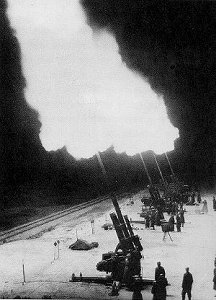 It is approximately 0120 hrs, the PFF is a few minutes late dropping their TIs, however the bomb- aimers see a faint glow of green markers and release their bombs. At 0127 hrs, LK-801 is a few minutes behind schedule, arriving late, at an altitude of 16,000 ft. The crew can only make out a fading glare through the cloud cover, and release their 18 x 500 lb bombs. The Halifax heads home gaining speed, continuing to drop Window for the benefit of any straggling Bombers.
It is approximately 0120 hrs, the PFF is a few minutes late dropping their TIs, however the bomb- aimers see a faint glow of green markers and release their bombs. At 0127 hrs, LK-801 is a few minutes behind schedule, arriving late, at an altitude of 16,000 ft. The crew can only make out a fading glare through the cloud cover, and release their 18 x 500 lb bombs. The Halifax heads home gaining speed, continuing to drop Window for the benefit of any straggling Bombers.
Left: A German Flak battery lights up the night sky.
LK-801 is about eight to ten minutes away from Sterkrade, turning from a north-eastern direction to a western homebound course. Rear gunner Sgt Cliff Wentworth, and Mid-upper gunner Sgt Clarence Soderstrom are pulling sentry duty in their respective turrets, maintaining surveillance for unwanted visitors. In the rear of the Halifax is a fighter warning device called Monica, with a range of four miles, however, the Wop/AG will use this with caution as enemy aircraft radar is designed specifically to home in on Monica`s signal. Clarence Soderstrom will flick Monica on momentarily hoping to get advance warning of enemy aircraft approaching, on occasion the rear gunner may get a visual of the enemy aircraft before Monica is engaged.
The Luftwaffe had many of their aircraft grounded due to weather, however the cloud cover is diminishing and a large number of night-fighters have managed to get airborne. A German controller is utilizing a radio beacon on a tower approximately 30 miles northwest of Sterkrade in the town of Bocholt, Germany. The beacon code-named "Kurfurst" is transmitting a homing signal for his fighters, for they have been orbiting, waiting for the order to attack the retreating enemy aircraft. The controllers are utilizing nine voice and two Morse channels concurrently to broadcast their running commentaries, i.e. information on location, height, and heading of the bomber stream for the benefit of the individual night-fighters, also changing frequencies every half-hour.
RAF Bomber Commands use of wide-ranging and complicated inventory of electronic counter-measures is not frustrating all the German controllers. The jamming is concentrated to the channels which are considered to be most dangerous, however one channel remains readable in England. Some of the bombers are equipped with a Mandrel jamming screen.
The German twin engine Junkers-88`s night-fighters can fly roughly 100 to 150 mph. faster then the Halifax bombers. Their armament, six 20 mm cannons and one 13mm cannon are very lethal. German Pilots will locate the vapour trails of retreating enemy aircraft at high altitudes and follow them to the source in minutes; they are also equipped with "Flensburg" an air interception homing device designed specifically for Monica.
At 0136 hrs, rear gunner Cliff Wentworth detects an aircraft coming up from behind and immediately calls for Mike Laffin to perform an evasive corkscrew maneuver. LK-801 goes into a diving turn and the rattle of Browning machine guns can be heard throughout the Halifax.
Seconds later the rear gunner speaks up: “resume course” adding, “he certainly is - - - - ing off in a hurry!” much to the relief of the crew. Laffin climbs the aircraft back up to an altitude of 16,000 feet, and Wentworth comments that it may have just been another Halifax.
0140 hrs, the rear gunner detects two JU-88`s rapidly approaching in from the rear, through his telecom Cliff Wentworth instructs the pilot to perform another corkscrew. Both gunners are firing their weapons, damaging one fighter, Wentworth observes it falling to earth in flames. Another "bogey" approaches and LK-801 responds with a diving turn, but not quick enough. As the second fighter scores direct hits on the starboard wing as it roars by, the crew hears the thumping of striking bullets on the Halifax. The fighter, momentarily is not a threat due to the corkscrew maneuver, however Clarence Soderstrom reports through his intercom that the starboard outer engine is on fire. Mike Laffin pushes the crippled aircraft into a dive, in hope of snuffing out the fire, then pulls up fast, but the engine continues to flame. Mike feathers the propellers and shuts down the burning engine; activating the Graviner switches to extinguish the fire is difficult.
A typical briefing for bomber crews of 431 and 434 squadrons at Croft Yorkshire. The two senior RCAF officers seated in the aisle are G/C R.S. Turnbull and W/C A.L. Blackburn. (CFJIC)
Mike Laffin begins to transfer fuel from the right wing tank to the left wing tank to avoid an explosion. Clarence Soderstrom announces that "the inner starboard engine is now on fire". Through his intercom, Mike Laffin inquires about injuries. Everyone reports back okay. Relieved, he orders the crew to bailout. No training resembles the situation the crew is in now; they are terrified, near panic, and prepare to bail out.
There are four avenues of escape in the Halifax; a small hatch above the pilot's head. A second narrow escape hatch, a trap door will lift out in the front lower section between the flight engineer`s/navigators area and the aircraft nose. The third exit is the main door located behind the left wing underside. The bomb-aimer, navigator, and wireless operator make sure all escape hatches are open on their levels. The rear gunner has the fourth exit, which is optional, he can climb out of his turret, strap on his parachute, reenter the turret, rotate it 180 degrees then fall clear from the aircraft.
Martin is preparing to jump, when someone suggests pressing on a little further. The pilot tells everyone to wait. Seconds pass. Clarence Soderstrom reports from the upper-turret "The fire is getting worse, it's now engulfing the wing". Fearing a gasoline explosion, and losing altitude, Mike Laffin gives the final order to bail out. Searchlights occasionally illuminate the aircraft, but the breaking cloud is still preventing anti-aircraft cannons from firing accurately.
When the bail out order is given, Jim Martin jumps first, followed by Greg Chapman; Ken Donaldson has also jumped. Cliff Wentworth climbs out of his turret, and heads for the main entrance. Jack Druett moves from the flight engineer area, which is a level below the pilot, to the main hatch. Clarence Soderstrom climbs down from the mid-upper-turret and makes his way toward the main door.
Jim Martin jumped at a considerably higher altitude then the rest of his crew. Looking up he sees his parachute has opened, but does not recall pulling his ripcord. Hearing the sound of other bombers above him, he fears that his parachute may snag an aircraft, or worse, get hit by a propeller, but soon realizes the bomber stream is well above him. He cannot see the ground and is trying to figure out how far he has drifted with the wind.
Jack and Cliff are about to jump, Jack leaves first, Cliff observes Clarence with his parachute approaching him, Cliff exits out the escape hatch, being the 5th Airman to leave.
Mike Laffin hears Clarence telling him that everyone is out. Observing a night fighter approaching, he yells at Clarence, "what are you waiting for? Get the hell out!" The JU-88 lets loose a stream of bullets, which rip through the Halifax, smashing the control column and injuring two of Mike's fingers. In the past fear inspiring minutes the escape hatch above his head was not opened, LK-801`s altitude has dropped well below 5,000 feet, and he is sitting on his parachute.
Through his intercom, Mike tries to make sure everyone is out. As there is no answer, he assumes he is the only one left. Making a crash landing crosses his mind but fate intervenes.
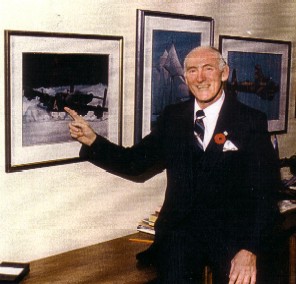 The right wing badly burned, the control column inoperable, the aircraft shaking; it rolls abruptly to the right, knocking Mike Laffin off his seat. Mike falls to the main deck, struggles with a parachute, suddenly the nose of the Halifax dips and he rolls out an open escape hatch and deploys his parachute. Upon landing on the edge of a farmers field, he also does not recall pulling his ripcord. He is feeling roughed up, knee aching, boots lost. He hides his parachute and sets out walking west, hoping to avoid capture. LK-801 has crashed nearby on the southern outskirts of Ruurlo, in Holland.
The right wing badly burned, the control column inoperable, the aircraft shaking; it rolls abruptly to the right, knocking Mike Laffin off his seat. Mike falls to the main deck, struggles with a parachute, suddenly the nose of the Halifax dips and he rolls out an open escape hatch and deploys his parachute. Upon landing on the edge of a farmers field, he also does not recall pulling his ripcord. He is feeling roughed up, knee aching, boots lost. He hides his parachute and sets out walking west, hoping to avoid capture. LK-801 has crashed nearby on the southern outskirts of Ruurlo, in Holland.
A photo from the mid 1990's shows Mike Laffin describing a painting of a Halifax bomber like the one he escaped from in June 1944.
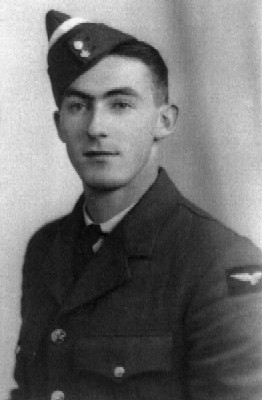 Meanwhile, Jim Martin is descending, rubbing his numb barefoot after loosing a boot and sock. He observes two distinct fires, wondering if one is the target they bombed, the other LK-801, or if they are both planes. Speculating where he is, moments later he lands in a wheat field and experiences a sharp pain in his ankle. The feeling has returned to his foot. Feeling safe for the moment he cuts strips from his parachute and wraps his ankle. He will evade capture till the following evening. During interrogation, German troops inform Jim that an Airman had died in the crash.
Meanwhile, Jim Martin is descending, rubbing his numb barefoot after loosing a boot and sock. He observes two distinct fires, wondering if one is the target they bombed, the other LK-801, or if they are both planes. Speculating where he is, moments later he lands in a wheat field and experiences a sharp pain in his ankle. The feeling has returned to his foot. Feeling safe for the moment he cuts strips from his parachute and wraps his ankle. He will evade capture till the following evening. During interrogation, German troops inform Jim that an Airman had died in the crash.
Left: A portrait of Laffin while undergoing flying training.
Cliff Wentworth lands in a farmers field and in attempting to hide his parachute he tunnels into a haystack and finds a hut hidden inside. He sleeps there till the next evening. That night a farmer and 2 other locals arrive, taking him to Jack Druett, who also had escaped, later meeting up with one more airman, F/O Kay. All evade capture.
Upon hitting the ground, Greg Chapman sees LK-801 crash in flames. He is soon taken prisoner.
A few days later Mike Laffin is turned in by Nazi sympathizers. German officers stage a mock trial convict him of murder. He is slated for execution but his sentence later reduced and he is sent to a PoW camp
Clarence Soderstrom is unable to escape the burning bomber. When the aircraft rolls to the right, the escape hatch on the left side is now facing up and the G forces prevent him from moving. German soldiers find his remains in the forward part of the wrecked aircraft. He is the only R.C.A.F. Airman buried in Ruurlo General Cemetery in the Netherlands.
End Notes:
-
On June 16th 1944 1, 4, 6, and 8 Bomber Groups sent 321 aircraft, consisting of 162 Halifaxes, 147 Lancasters, and 12 Mosquitoes went to "Happy Valley". Approximately 21 bombers were shot down by fighters, and a further 10 by flak. Airmen missing this night totaled just over 200, of which 150 were killed, 50 taken PoW, and 8 evaded capture.
-
6 Bomber Group RCAF reported eight aircraft missing from 431, and 434 Squadrons, fifty-six airmen failed to return to their base at Croft.
-
Royal Air Force photo reconnaissance and German reports agree that most of the bombing at Sterkrade-Holten was scattered, although some bombs did fall in the plant area, but with little effect on production. Twenty-one Germans and six foreigners were killed while 18 houses in the vicinity were destroyed.
-
Rear gunner Cliff Wentworth`s claim of shooting down a JU-88 remains unconfirmed as another witness was required for a claim.
-
Update May 2021 - NightFighter Pilot claim by Lt Hans Schafer 7/NJG2 - estimate 20km E-NE of Arnheim (HN 8): 4,800m at 01:47.
(Nachtjagd Combat Archives 1944 Part 3 - Theo Boiten) -
Incorrect; Oberleutnant Erich Lippert, of 10./NJG3 (Night-Fighter Group) claimed to destroy a four engine aircraft at 01:40 hrs, location F.F. Kurfurst (F.F. means Funkfeuer or radio beacon near Bocholt, Germany) at 4700 meters (15,420 ft) altitude where interception took place. Ju-88 has a crew minimum of three. It is most probable this aircraft was responsible for LK-801`s fate.
(Ed note: Al Soderstrom of Edmonton is a nephew of the late Clarence Soderstrom. Dr. Mike Laffin lives in New Waterford, N.S.)


